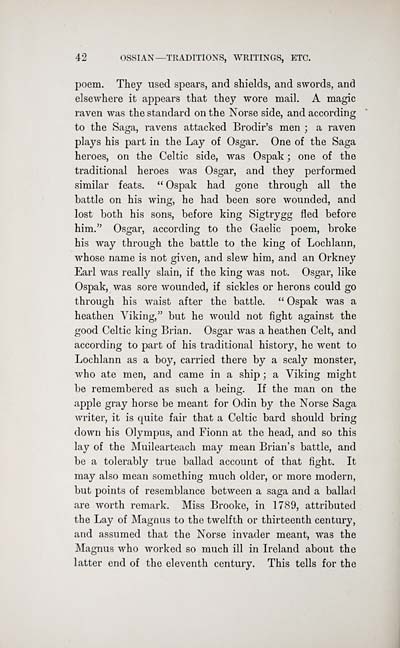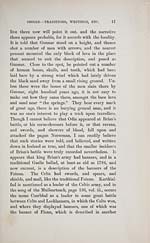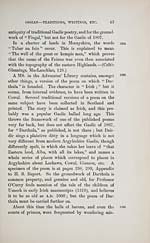Download files
Complete book:
Individual page:
Thumbnail gallery: Grid view | List view

42 OSSIAN— TRADITIONS, WRITINGS, ETC.
poem. They used spears, and shields, and swords, and
elsewhere it appears that they wore mail. A magic
raven was the standard on the Norse side, and according
to the Saga, ravens attacked Brodir's men ; a raven
plays his part in the Lay of Osgar. One of the Saga
heroes, on the Celtic side, was Ospak ; one of the
traditional heroes was Osgar, and they performed
similar feats. " Ospak had gone through all the
battle on his wing, he had been sore wounded, and
lost both his sons, before king Sigtrygg fled before
him." Osgar, according to the Gaelic poem, broke
his way through the battle to the king of Lochlann,
whose name is not given, and slew him, and an Orkney
Earl was really slain, if the king was not. Osgar, like
Ospak, was sore wounded, if sickles or herons could go
through his waist after the battle. " Ospak was a
heathen Viking," but he would not fight against the
good Celtic king Brian. Osgar was a heathen Celt, and
according to part of his traditional history, he went to
Lochlann as a boy, carried there by a scaly monster,
who ate men, and came in a ship ; a Viking might
be remembered as such a being. If the man on the
apple gray horse be meant for Odin by the Norse Saga
writer, it is quite fair that a Celtic bard should bring
down his Olympus, and Fionn at the head, and so this
lay of the Muilearteach may mean Brian's battle, and
be a tolerably true ballad account of that fight. It
may also mean something much older, or more modern,
but points of resemblance between a saga and a ballad
are worth remark. Miss Brooke, in 1789, attributed
the Lay of Magnus to the twelfth or thirteenth century,
and assumed that the Norse invader meant, was the
Magnus who worked so much ill in Ireland about the
latter end of the eleventh century. This tells for the
poem. They used spears, and shields, and swords, and
elsewhere it appears that they wore mail. A magic
raven was the standard on the Norse side, and according
to the Saga, ravens attacked Brodir's men ; a raven
plays his part in the Lay of Osgar. One of the Saga
heroes, on the Celtic side, was Ospak ; one of the
traditional heroes was Osgar, and they performed
similar feats. " Ospak had gone through all the
battle on his wing, he had been sore wounded, and
lost both his sons, before king Sigtrygg fled before
him." Osgar, according to the Gaelic poem, broke
his way through the battle to the king of Lochlann,
whose name is not given, and slew him, and an Orkney
Earl was really slain, if the king was not. Osgar, like
Ospak, was sore wounded, if sickles or herons could go
through his waist after the battle. " Ospak was a
heathen Viking," but he would not fight against the
good Celtic king Brian. Osgar was a heathen Celt, and
according to part of his traditional history, he went to
Lochlann as a boy, carried there by a scaly monster,
who ate men, and came in a ship ; a Viking might
be remembered as such a being. If the man on the
apple gray horse be meant for Odin by the Norse Saga
writer, it is quite fair that a Celtic bard should bring
down his Olympus, and Fionn at the head, and so this
lay of the Muilearteach may mean Brian's battle, and
be a tolerably true ballad account of that fight. It
may also mean something much older, or more modern,
but points of resemblance between a saga and a ballad
are worth remark. Miss Brooke, in 1789, attributed
the Lay of Magnus to the twelfth or thirteenth century,
and assumed that the Norse invader meant, was the
Magnus who worked so much ill in Ireland about the
latter end of the eleventh century. This tells for the
Set display mode to: Large image | Transcription
Images and transcriptions on this page, including medium image downloads, may be used under the Creative Commons Attribution 4.0 International Licence unless otherwise stated. ![]()
| Early Gaelic Book Collections > Matheson Collection > Popular tales of the west Highlands > Volume 4 > (58) |
|---|
| Permanent URL | https://digital.nls.uk/81487753 |
|---|
| Description | Volume IV. |
|---|---|
| Shelfmark | Mat.77 |
| Additional NLS resources: | |
| Attribution and copyright: |
|
| Description | Items from a collection of 170 volumes relating to Gaelic matters. Mainly philological works in the Celtic and some non-Celtic languages. Some books extensively annotated by Angus Matheson, the first Professor of Celtic at Glasgow University. |
|---|
| Description | Selected items from five 'Special and Named Printed Collections'. Includes books in Gaelic and other Celtic languages, works about the Gaels, their languages, literature, culture and history. |
|---|

